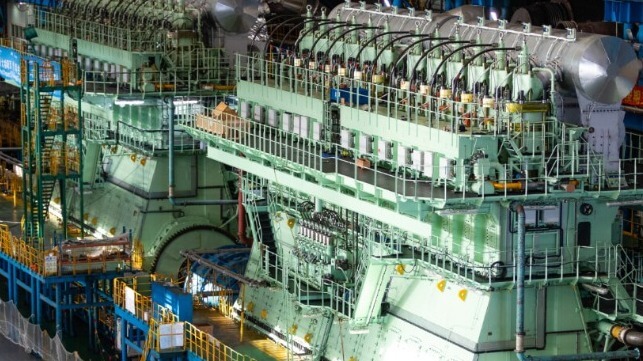WinGD Predicts Ammonia-Fueled Engines for Q1 2025 and in Service in 2026

The race to get the ammonia-fueled engines into the commercial market continues, with WinGD, part of China’s CSSC Group, reporting it is on track to deliver ammonia engines in 2025. The Swiss-based marine power company provided its latest update citing progress in its testing and its collaboration with shipping companies.
WinGD highlights the strong collaborations happening across the industry to advance ammonia which is viewed as one of the most promising applications to achieve decarbonization in the maritime industry. The engine manufacturer highlights its efforts with engine and shipbuilders in China, Japan, and Korea, as well as class society and its own extensive investment in research.
The Swiss company is reporting that it is on track to deliver its first X-DF-A dual-fuel ammonia engines by the first quarter of 2025, with the first X-DF-A powered vessels in service from 2026. This follows combustion tests at WinGD research facilities in December 2022, which further demonstrated the advancements in ammonia-fueled engine design.
Tests on its purpose-built single-cylinder engine located at its Engine Research & Innovation Centre (ERIC) in Winterthur, and a multi-cylinder test engine at WinGD’s Global Test Centre in Shanghai will commence, in collaboration with China Shipbuilding Power Engineering Institute Co. (CSPI). WinGD highlights that it completed first ignition in 2022, and is quickly gaining knowledge including developing modeling for accurate figures for ammonia consumption and emissions. The company is working on two-stroke combustion concepts and emission models.
They are highlighting their process just days after Germany-based MAN Energy Solutions announced last week the first running of one of its two-stroke engines on ammonia at a test facility in Copenhagen. They recently highlighted their first successful ammonia combustion using the same two-stroke engine.
Other engine manufacturers are also making strong progress in their efforts. Wärtsilä began running progressive amounts of ammonia fuel in a four-stroke in 2020, and Japan Engine followed suit in 2023. Japan Engine also reported in April 2023 that it has begun co-firing ammonia with the fuel oil in a two-stroke engine.
“For the industry to be truly ready for alternative fuels, the engine concepts that use them – and the vessel designs, auxiliary systems, crew training, and field support network - need to be ready before the fuels become widely available,” said Dominik Schneiter, CEO of WinGD. “Our development timeframe, as evidenced by these milestones in research and collaboration, shows that we are on track to give shipowners and operators the time they need to prepare for decarbonized ship power using ammonia as fuel.”
Shipowners are anticipating these developments, proceeding with orders for ammonia-ready vessels. CMB (Compagnie Maritime Belge) reported that it recently took deliver on the world's first ammonia-ready containership. Built in China. the vessel is operating for CMA CGM and will be followed by similar vessels also designed for operations with ammonia fuel in the future. CMB.Tech also has a partnership with WinGD to develop ammonia-fueled engines for ten 210,000 DWT bulk carriers. Similarly, last month AET Tankers and sister company Akademi Laut Malaysia last month signed an agreement with WinGD to develop crew training on ammonia engines. WinGD also highlights that it has recently signed agreements with both Mitsubishi Shipbuilding Co. and Hyundai Heavy Industries in 2022 focusing on the development of designs for ammonia-fueled vessels.
Despite the challenges still to be overcome including the safety features for handling and operating with ammonia, its lack of carbon emissions continues to make it a leading candidate for the future both of the maritime industry and other heavy industries faced with the challenge of decarbonization. Most analysts continue to predict that the challenges will be overcome and by mid-decade forecast that ammonia fuel technology will reach commercialization.
